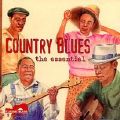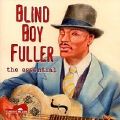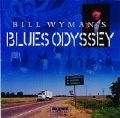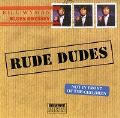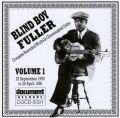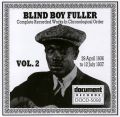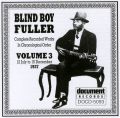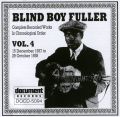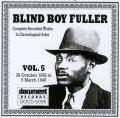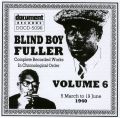"Search Document Records - Blind Boy Fuller Results "
Viewing 1 to 10 of 10
Country Blues, the essential DOUBLE CD More Info on our New Store >> |
||
Blind Boy Fuller, the essential DOUBLE CD More Info on our New Store >> |
||
Bill Wyman's Blues Odyssey DOUBLE CD Double CD
Various Artiists
Compiled by Bill Wyman
Informative 24 page full colour booklet by Bill Wyman & Richard Havers
Detailed discography
Rolling Stones bassist Bill Wyman asked Document Records to produce a CD which would be part of a life long ambition; to pay tribute to and share with others the music that he has loved and been influenced by, The Blues. This double CD, accompanied by a twenty-four page colour booklet, compliments the book, television documentary and DVD of the same name. It features some of the very best blues to have been recorded from the early “Classic” female blues and “Country Blues” of the nineteen-twenties through to the electric “Down Home” blues of Chicago.
Whether you are a collector or just inquisitive about what the blues are and the history the music, this CD is one of the finest collections of vintage blues recordings available. Continued... More Info on our New Store >> |
||
Rude Dudes - Part 2 Of Bill Wyman's Blues Odyssey Double CD.
Various Artists.
Informative, 12 page, full colour illustrated, booklet notes by Neil Slaven & Bill Wyman.
Detailed Discography.
Banana In Your Fruit Basket, If It Don't Fit Don't Force It and He's Just My Size? Well, no prizes for guessing what they're all about. But what is a Southern Can, who is the Boy in the Boat and why a Man O' War? This excellent double CD, with twelve page full colour booklet, is packed with some of the most intriguing and often humorous Hokum, Blues, Jazz and Boogie-Woogie pieces based on the subject of sex. Outrageous double entendres and curious metaphors are abound. If Bananas, Lollypops, Fish and Jelly be the food of love, then play on! Continued... More Info on our New Store >> |
||
Blind Boy Fuller Vol 1: 23rd Spetmber 1935 to 29th April 1936 Blind Boy Fuller, vocal, guitar.
With contributions by, Blind Gary Davis, guitar; Bull City Red, washboard.
Genres: Country blues, Piedmont blues, Country blues guitar, ragtime guitar.
Informative booklet notes by Ken Romanowski.
Detailed discography.
Review by John Morthland Along with Blind Willie McTell, Fuller is the most compelling of the Piedmont bluesmen, an intricate guitarist and robust singer with a large and varied repertoire; he was also one of the last commercially potent country bluesmen. The North Carolina street singer was best known for nimble, acrobatic rags: Step It Up and Go and Trucking My Blues are the most enduring, though Rag, Mama, Rag (with Rev. Gary Davis), Piccolo Rag and Big Leg Woman Gets My Pay are nearly as strong. Davis was also devastating on slow blues like Keep Away From My Woman and My Brownskin Sugar Plum, and virtuoso slide workouts like Homesick and Lonesome Blues. entendres like What's That Smells Like Fish and suitably pious on gospel material like Davis' Twelve Gates to the City. He may have been a synthesizer rather than innovator, but hey, so was Robert Johnson. In the case of both men, nobody did it better. More Info on our New Store >> |
||
Blind Boy Fuller Vol 2: 29th April 1936 to 12th July 1937 Blind Boy Fuller, vocal, guitar.
With contributions by Dipper Boy Council, guitar; Bull City Red, washboard.
Genres: Country Blues, Piedmont Blues, Carolina Blues, Blues Guitar, Ragtime Guitar.
Inforamtive booklet notes by Ken Romanowski.
Detailed discography.
The second volume in Document's chronological overview of Blind Boy Fuller's life and music contains some of his most popular recordings, including the 1936 sessions which yielded both Truckin' My Blues Away (an update of Tampa Red's "What Is It That Tastes Like Gravy?") and Mama Let Me Lay It on You (a rendition of Memphis Minnie and Kansas Joe's "Can I Do It for You?"), both of them definitive versions. Continued... More Info on our New Store >> |
||
Blind Boy Fuller: Vol 3 12 July to 15th 1937 Blind Boy Fuller, vocal guitar.
With contributions by Sonny Terry, harmonica.
Genres: Country blues, Piedmont blues, Carolina blues, Blues guitar, Ragtime guitar.
Informative booklet notes by Ken Romanowski
Detailed discography.
Review by Jason Ankeny The 22 sides which comprise the third volume in Document's Blind Boy Fuller retrospective were all culled from sessions cut in the latter half of 1937; the first session, from mid-July, was recorded under the auspices of the Decca label, a situation which left Fuller's longtime manager J.B. Long -- as well as ARC Records -- none too happy. As a result, at the bluesman's next session, Long insisted he re-record many of the titles earlier cut for Decca, resulting in alternate takes of Bulldog Blues, Throw Your Yas Yas Back in Jail (a.k.a. "Put You Back in Jail") and Steel Hearted Woman (a.k.a. "Why Don't My Baby Write to Me"); for blues historians, the chance to compare and contrast the sessions will be irresistible. More Info on our New Store >> |
||
Blind Boy Fuller Vol 4: 15th December to 29th October 1937 - 1938 Blind Boy Fuller, vocal, guitar.
With contributions by Dipper Boy Council, guitar; Sonny Terry, harmonica; Charlie Austin, harmonica; Bull City Red, washboard.
Genres: Country blues, Piedmont blues, Blues guitar, Carolina blues, Ragtime guitar, Blues harmonica.
Informative booklet notes by Ken Romaowski.
Detailed discography.
Review by Jason Ankeny.
Beginning with the mid-December, 1937 session which kicks off this fourth volume in Document's retrospective, Blind Boy Fuller entered into a recording partnership with the legendary harpist Sonny Terry that continued for the remainder of Fuller's studio career. Terry's blistering harmonica and falsetto interjections lent an exciting new dynamic to Fuller's sound, as classic sides like Pistol Snapper Blues, Mean and No Good Woman and Georgia Ham Mama amply prove, each musician pushing the other to new creative heights. More Info on our New Store >> |
||
Blind Boy Fuller Vol 5: 29th October 1938 to 5th March 1940 Blind Boy Fuller, vocal, guitar.
With contributions by Sonny Terry, harmonica; Bull City Red, washboard; possibly Sonny Jones, guitar.
Genres: Country blues, Piedmont blues, Carolina blues, country blues guitar, Ragtime guitar, Blues harmonica.
Informative booklet notes by Ken Romanowski.
Detailed discography.
Review by Jason Ankeny:
Volume five in Document’s Blind Boy Fuller series is comprised primarily of two prolific sessions, the first recorded in Columbia, South Carolina on October 29, 1938 with harpist Sonny Terry and washboard player Bull City Red, the second a Memphis date from July 12, 1939 with Terry, Bull City Red (now going as Oh Red) and second guitarist Sonny Jones. The latter is perhaps the most impressive, yielding the signature song I Want Some of Your Pie as well as You’ve Got Something There (a rewrite of Buddy Moss’ “Daddy Don’t Care”) and Fuller’s immortal rendition of J.B. Long’s Step It Up and Go. More Info on our New Store >> |
||
Blind Boy Fuller Vol 6 1940 Blind Boy Fuller, vocal, guitar.
Brother George And His Sanctified Singers (Blind Boy Fuller)
With contributions by Sonny Terry, vocal, harmonica; Oh Red, washboard.
Genres: Country blyues, Piedmont blues, Carolina blues, Country blues guitar, Country blues harmonica.
Informative bookle notes by Ken Romanowski.
Detailed discography.
Review by Jason Ankeny: The sixth and final volume in the series assembles the fruits of Blind Boy Fuller’s final studio sessions, all dating to the first half of 1940. Despite failing health, Fuller is at his most incendiary on these sides — Shake It, Baby is among his most galvanizing dance tunes, while Little Woman You’re So Sweet stands as one of his finest originals. Most energetic, however, are the sanctified songs, including No Stranger Now, Jesus Is a Holy Man and Twelve Gates to the City — with his death less than a year away, Fuller burns with spiritual intensity, clearly yearning for some kind of redemption in his final months. More Info on our New Store >> |
||

